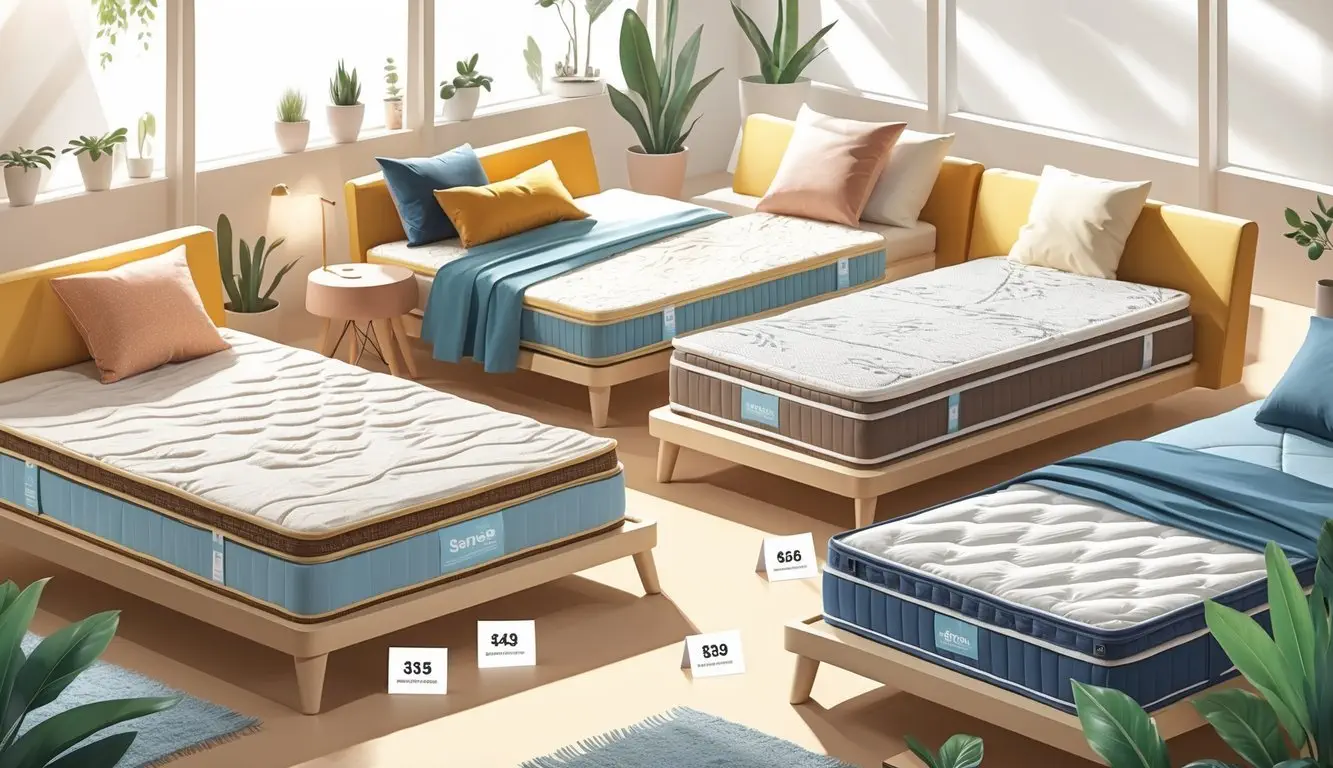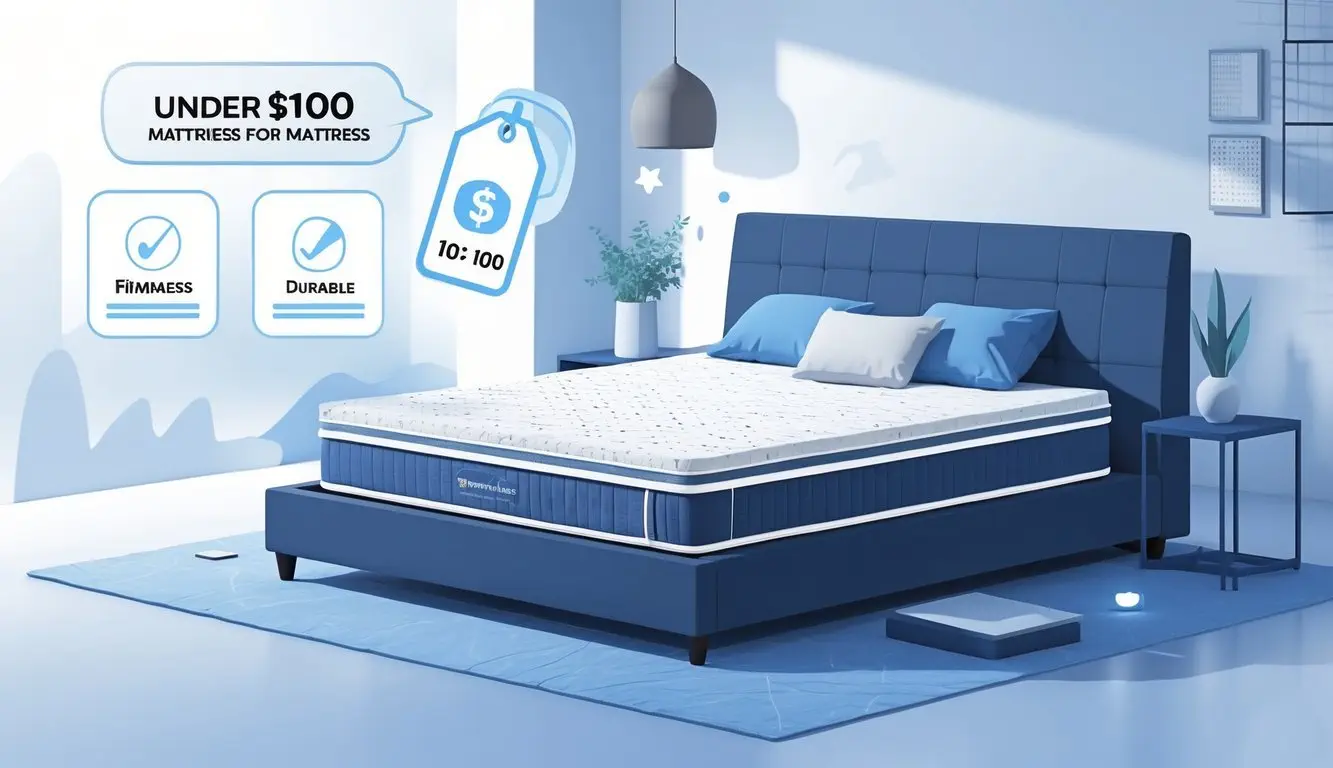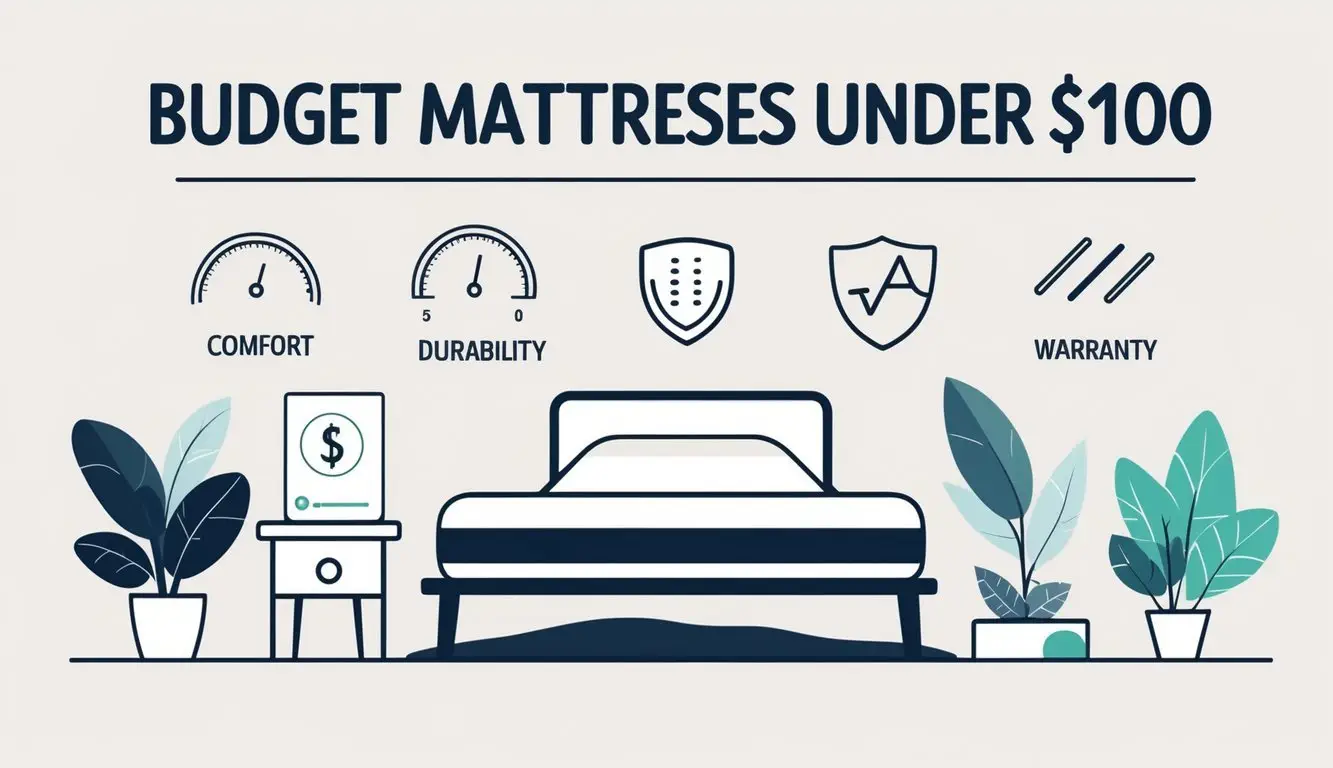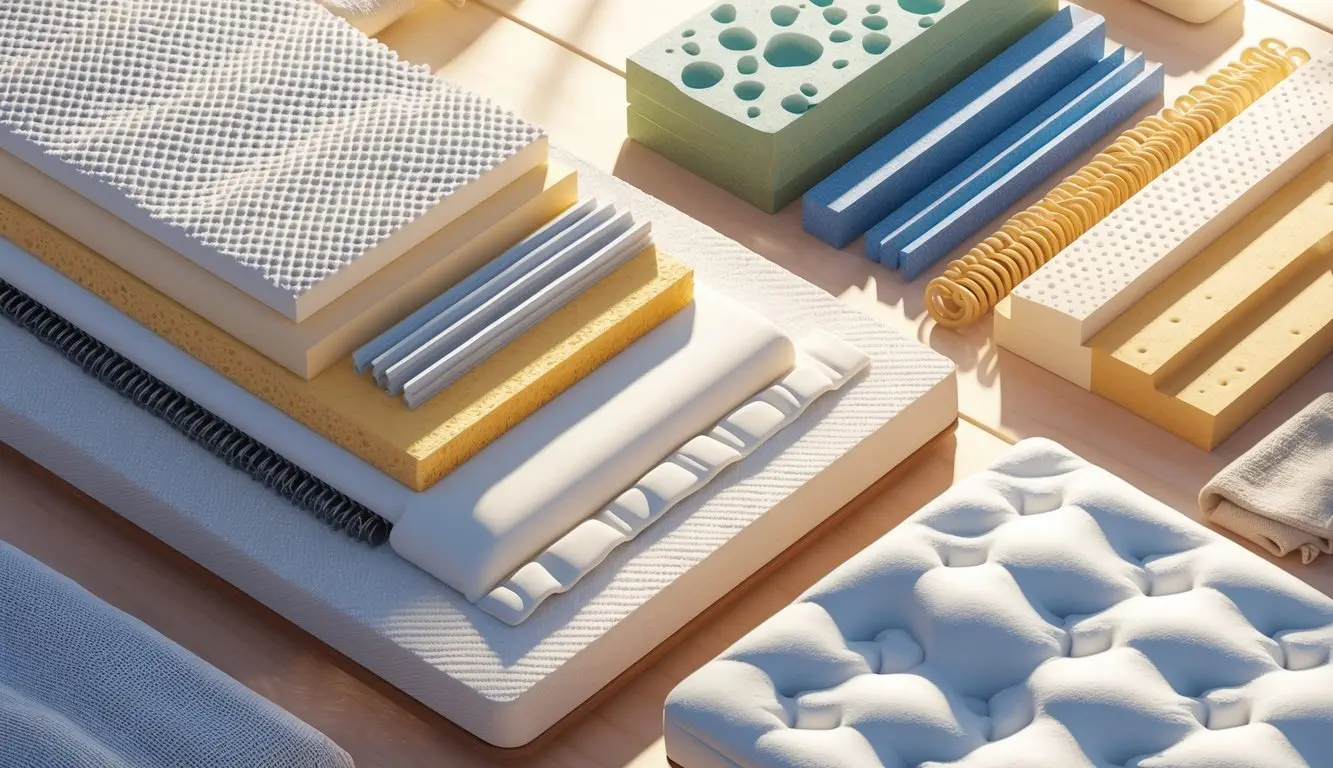The best mattress under $100 is one that gives you comfort and support without breaking your budget. Many budget mattresses offer features like foam layers, basic spring support, and easy shipping right to your door.

Shoppers with tight budgets can still find good value choices. Brands now offer affordable mattresses that work well for guest rooms, kids, or anyone who needs a simple and comfortable sleep surface.
Mattresses under $100 can be found online or in some stores, and these options are perfect for people who want to save money. With careful research, it’s possible to sleep better for less.
What to Expect From the Best Mattress Under $100

A mattress under $100 usually has basic construction, limited features, and modest durability. These mattresses focus on offering temporary comfort for those with tight budgets or short-term needs.
Key Characteristics and Limitations
Most mattresses under $100 use simple materials, such as low-density foam or thin quilted fiber. They are usually all-foam mattresses, which are lightweight and easy to move.
Buyers can expect limited thickness, often between 4 to 8 inches. Extra features like cooling gels or reinforced edges are rare. The comfort level tends to be medium-firm, but support may not match more expensive models. These mattresses may not provide enough firmness for heavier individuals or those who need special back support.
Common limitations include low weight capacity, minimal edge support, and potential for sagging. There may be a slight chemical smell at first, especially for memory foam. Brands often provide basic warranties, if any.
Types of Mattresses at This Price Point
Under $100, memory foam and all-foam mattresses are the most common. Some foam mattresses use polyurethane foam, which is less dense and less durable than higher-end foam types.
A few hybrid mattresses exist in this range, but they tend to be thin and use low-cost materials. These hybrids may have a simple innerspring unit combined with a foam top, but the coil count is usually low. Most do not offer the same bounce or support found in pricier hybrid models.
The majority of options are twin or full sizes, as queen and king mattresses are rare at this price. If larger sizes are available, they often sacrifice comfort and durability to lower the cost further.
Average Lifespan and Durability
A mattress in this range should be viewed as a short-term solution. On average, a supportive mattress under $100 may last anywhere from 1 to 3 years with regular use.
Thinner foam or weak springs can develop indentations and lose support quickly. The cover material may also wear down, leading to visible sagging or lumps. Frequent moving or folding can speed up wear and tear.
These mattresses are best used for guest rooms, college dorms, or temporary sleeping needs. For nightly use, users may notice softening, uneven surfaces, or reduced comfort after several months.
Essential Buying Criteria for Budget Mattresses

People shopping for a mattress under $100 should balance price with sleep quality. Choosing the right firmness, pressure relief, and motion isolation is key for both comfort and long-term value.
Comfort and Firmness Considerations
A good bed should feel comfortable right away. Mattresses often use foam or thin comfort layers to soften the sleep surface. The right firmness depends on sleep position and body type. Side sleepers usually need a softer mattress, while back or stomach sleepers prefer something firmer for support.
It is important to check if the mattress feels too hard or lets you sink in too much. Many budget mattresses are medium-firm, which suits most people. Some may use egg crate foam for extra padding. Look for clear descriptions or charts from the seller about firmness level and thickness.
Mattresses that are too soft may lose shape fast, causing discomfort. If comfort layers are too thin, pressure points can build up, especially around hips and shoulders. Testing out or reading reviews about feel and comfort can help avoid regrets.
Pressure Relief and Support
Pressure relief is important for reducing pain and soreness during sleep. A mattress with good support will spread weight evenly and cushion the main pressure points. In cheaper beds, this is mostly handled by the top foam layer or quilting.
If the mattress is too firm, it may press into the hips and shoulders. If it is too soft, the spine can bow, leading to back issues. Look for features like contoured foam or fiberfill layers that give a small amount of push-back but still allow some give.
Support is mostly about how well the bed holds up under body weight. Heavier people may need a thicker or denser foam layer for real support. In listings, terms like “high-density foam” and “pressure-relief zones” point to better support and comfort design.
Motion transfer matters a lot when two people share a bed. If one person moves or gets up, a mattress with poor motion isolation will make the other person feel every shift. Memory foam or thick foam layers absorb most movement, keeping sleep more peaceful.
Budget mattresses with basic foam cores often do well at stopping motion from spreading. However, thin or cheap coils may create bounce, causing disturbances for light sleepers. Look for reviews or seller comments about whether the mattress is “quiet” or has “low motion transfer.”
Features to watch for include solid foam cores, extra padding layers, and tight covers. These help reduce motion and create a calm place to sleep, even in a low-cost bed. Reading customer feedback is useful for checking real-world motion isolation.
Best Mattress Materials Available Under $100

Mattresses under $100 are usually made from different types of foam materials. These low-cost options can offer comfort and reasonable support for short-term or light use.
Affordable Memory Foam Options
Memory foam is popular for mattresses under $100 because it is cost-effective and molds to the shape of the sleeper’s body. Most memory foam mattresses in this range have a thickness of 6 to 8 inches. This provides gentle pressure relief for light sleepers or children.
Common features include basic polyurethane memory foam, with no extra cooling or advanced layers. Some brands use foam certified by CertiPUR-US, which means fewer harmful chemicals. Shoppers should check for certifications and focus on mattresses with breathable covers, even if they are not organic cotton. Support is often best for side or back sleepers who don’t need a firm surface.
In summary, while memory foam mattresses at this price point lack luxury features, they can still offer consistent shaping and comfort for budget needs.
Foam and All-Foam Designs
All-foam mattresses are the most common type found under $100. These use layers of basic polyfoam, sometimes mixed with a thin layer of comfort foam or gel for added softness. The structure usually features a core layer of firmer foam with a softer top for comfort.
Foam mattresses at this price do not typically contain springs, latex, or luxury fibers. The cover material may be simple polyester and rarely includes organic cotton due to cost. These mattresses are lightweight, easy to move, and often shipped in compressed boxes.
Most all-foam models have limited edge support and may feel softer as they age. They are best for people who need an affordable, basic option or temporary sleeping solution rather than a permanent bed.
Hybrid and Innerspring Mattress Alternatives

Hybrid and innerspring mattresses often use pocketed coils to offer support, bounce, and airflow. Shoppers can sometimes find budget versions of these beds, but the quality varies.
Pocketed Coil Constructions
Pocketed coils are individual springs wrapped in fabric sleeves. This type of construction reduces motion transfer compared to older, connected coils. People who share a bed may notice less disturbance when someone moves at night.
These mattresses usually have a firmer feel and more bounce than all-foam beds. They often include a thin foam or fiber layer on top for some softness.
A bed frame is important for pocketed coil mattresses. Slatted frames let the coils breathe, while solid surfaces may make the bed feel firmer. Just adding a box spring or sturdy base is usually enough.
Some key benefits of pocketed coil beds:
- Better airflow than foam beds
- Good support, especially for heavier sleepers
- Less motion transfer compared to traditional innersprings
Budget pocketed coil mattresses are not as common below $100. However, they do appear during sales or in twin and full sizes.
Comparing Hybrid vs. Foam Beds
Hybrid mattresses mix pocketed coils and foam layers. This creates a balance between comfort, support, and airflow. All-foam beds use only foam and tend to trap more heat.
Hybrid mattresses offer more edge support, so people can use the entire surface of the bed without feeling like they might roll off. They also bounce back faster when someone changes position, which can make it easier to move.
Foam beds are lighter and usually cheaper. They make less noise and are easier to move, while hybrids feel sturdier on a bed frame due to their coil system.
Under $100, hybrid choices may be limited. Foam beds are much more common at this price. Shoppers should check descriptions closely to confirm if a mattress actually uses pocketed coils or just basic foam.
Additional Bedding Essentials for Better Sleep

Budget mattresses can help with money savings, but other bedding choices also affect how well a person sleeps. Key essentials like bed frames, foundations, pillows, and sheets make a difference in comfort and support.
Bed Frames and Proper Foundation
A sturdy bed frame is important in keeping a mattress in place. It helps prevent sagging and supports the sleeper’s body weight. Metal and wood bed frames are both common. Metal frames are durable and often cost less, while wood frames offer a classic look but may cost a little more.
A good foundation, such as a box spring, should be chosen to match the mattress type. Slatted bases work well with most mattresses if the slats are close together. Directly placing a mattress on the floor may block airflow, which can lead to moisture and mold problems.
A strong and level base helps a mattress last longer. For most, an easy-to-assemble frame and foundation are both practical and affordable.
Choosing Pillows and Sheets
A pillow should keep the neck in line with the spine. Proper neck support can prevent waking up with pain or stiffness. Memory foam, fiberfill, and polyester pillows are good choices for people looking for low-cost options.
Sheets made from materials like cotton or microfiber are usually soft and easy to wash. Thread count between 200–400 is comfortable for most people. Fitted sheets should match the mattress depth to avoid bunching or slipping.
Clean bedding is linked with better sleep. It’s best to wash sheets and pillowcases once a week to remove dirt, sweat, and allergens. Choosing the right combination of pillows and sheets helps make sleep spaces more inviting and comfortable.
Warranty, Return Policies, and User Protections

Choosing a mattress under $100 often means having fewer guarantees, but there are still important protections. Buyers should check the fine print on warranty terms and return details before making a purchase.
Understanding Warranty Coverage
Warranties for low-cost mattresses are usually limited. Many options under $100 offer warranties ranging from 30 days up to 1 year. It is important to check exactly what is covered.
Most basic warranties only protect against defects in materials or workmanship. This often includes things like broken springs, ripped seams, or foam that fails to expand as promised. Normal wear and tear or user-caused damage is usually not included.
Customers may need to give proof of purchase and may have to pay shipping fees for returns or repairs. Some sellers require that you keep original packaging to use the warranty. Always read the warranty policy before buying. Look for companies that clearly explain coverage and contact options for help.
Example Table:
| Mattress Brand | Typical Warranty Length | Proof Needed | What’s Covered |
|---|---|---|---|
| Generic Online | 90 days | Receipt | Defects, not user damage |
| Local Store Brand | 1 year | Receipt, tags | Springs, foam defects |
Evaluating Return and Trial Periods
Return policies for cheap mattresses can be strict. Some stores offer no returns, while others may allow returns within 7 to 30 days if the product is unused and in the original packaging.
Trial periods—where the buyer can use the mattress and still return it—are rare under $100. If present, they usually last only one or two weeks, and may come with restocking or pickup fees. This limits a buyer’s ability to truly test the product.
Check if the refund is given in cash, store credit, or only as an exchange. Always confirm if you are responsible for return shipping. Consent to the return policy is required before the sale, so read every point clearly.
Before checkout, look for a clear return policy and contact information for customer service. Making sure these protections are in place helps if the mattress does not meet expectations.
Privacy and Security Considerations When Shopping Online

Online mattress shopping often requires sharing personal information and making secure payments. It is important to pay attention to how privacy settings and cookies work and to make sure all transactions are protected against fraud.
Managing Privacy Settings and Consent
Many mattress websites ask users to give consent to use cookies or collect personal data. People should look for privacy banners or notifications with options like “Accept All”, “Reject All”, or “Manage Privacy Settings”.
Clicking “Manage Privacy Settings” lets users control what information sites can collect. Some platforms, like Yahoo, offer a privacy dashboard to help review and change privacy choices. This can include what type of content measurement, analytics, or audience research is allowed.
Users can often decide if they want sites to access their geolocation data or search data. Adjusting these settings helps limit tracking and unwanted data sharing.
Understanding Cookies and Data Usage
Cookies are small files websites store on the device to remember things like login details, shopping cart items, and browsing history. Some cookies are necessary for the site to work, but others track personal data for marketing or analytics.
Many online stores describe their cookie policy and let shoppers change cookie settings. There is often an option to only allow essential cookies and block those used for advertising or tracking.
Data collected may include IP address, device type, and user activity. Understanding which cookies are being used and what information is collected helps protect user privacy. Reading the cookie policy before accepting cookies gives shoppers more control over their personal information.
Ensuring Safe Transactions and User Authentication
Safe transactions rely on good security measures. Look for signs like a padlock symbol in the browser’s address bar and a web address that starts with “https://” before entering any payment details. These indicate the site uses encryption.
Many retailers use user authentication to verify who is making a purchase. This might include two-factor authentication, email verification, or sending a code to a phone.
Some websites also implement tools to detect and prevent spam or fake users. Shoppers should avoid saving payment details on public devices and should log out when finished. Secure payment and good authentication help protect against threats like unauthorized access or stolen information.
Frequently Asked Questions

Mattresses that cost less than $100 are often basic foam or innerspring types. Some shoppers may still find decent options, especially from online retailers or sales.
What are the top affordable full-size mattresses available for under $100?
Many top choices are thin foam mattresses, such as the Linenspa 5-Inch Gel Memory Foam Mattress. Some no-brand innerspring beds on Amazon and Walmart also sell for below $100. These usually don’t include premium materials but may provide a temporary sleep solution.
How can I find a queen mattress that provides good value for under $100?
Buying a queen mattress under $100 often requires waiting for major holiday sales or checking online marketplaces. Stores like Amazon, Walmart, and Overstock sometimes have deals on basic foam beds. Used or “open-box” mattresses may also be an option.
What are some recommended mattresses for back pain relief within a $100 budget?
For back support, most mattresses under $100 are not specialty models. A medium-firm foam bed may be the best bet in this price range. Adding a low-cost mattress topper could also help improve comfort if support is lacking.
Where can I buy a reliable mattress online for less than $100?
Reliable options are often found at Amazon, Walmart, and Wayfair. These retailers offer new mattresses from lesser-known brands and sometimes feature customer reviews that help assess quality.
Can you get a mattress with a boxspring included for under $100?
It is uncommon to find a new mattress and boxspring set below $100. Most sets will cost more, but some online marketplaces may have used or refurbished sets in this price range, especially in twin size.
Are there any mattresses under $100 offering free shipping?
A few online stores and Amazon sellers offer free shipping for mattresses under $100. Shipping details vary by location and seller, so it is important to check listings carefully before buying.